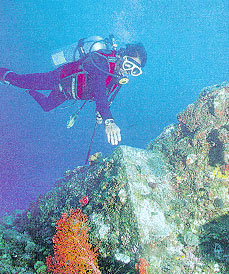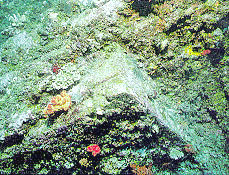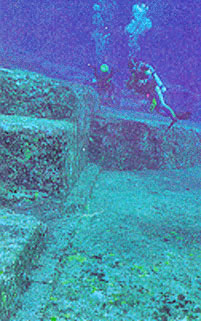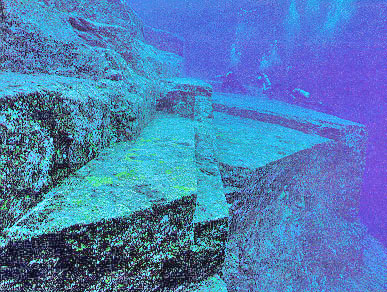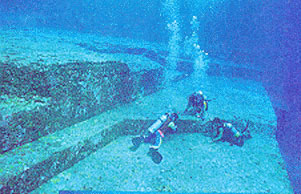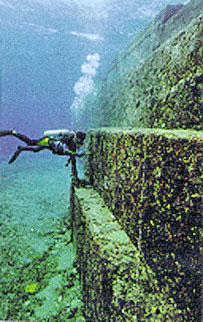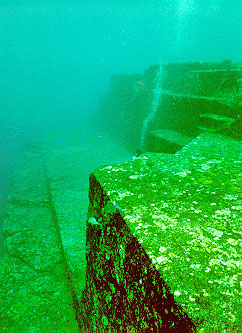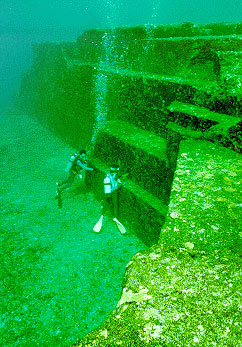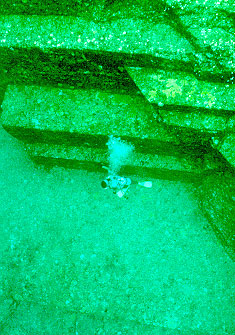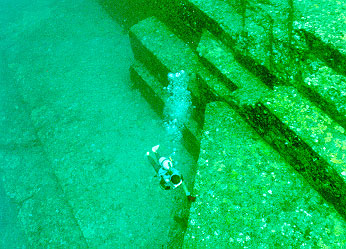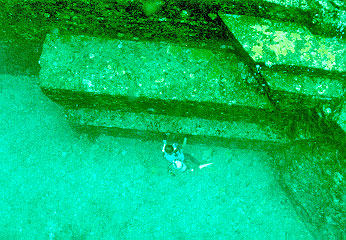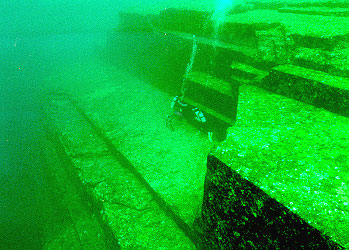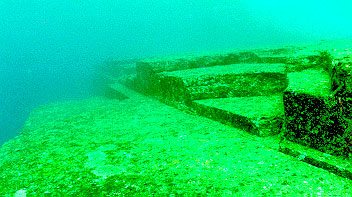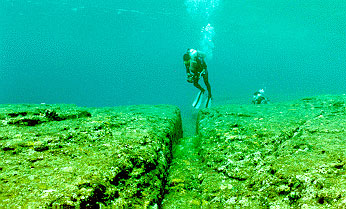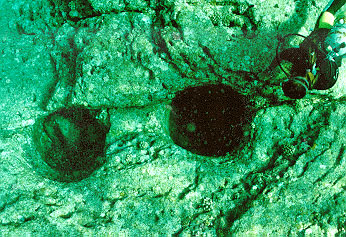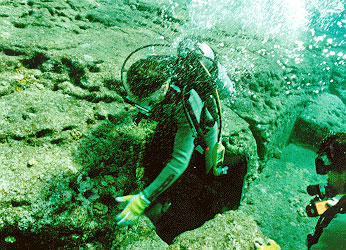|

by Laura Lee
from
LauraLee Website
YONAGUNI: The ancient
underwater pyramid structure off the coast of Yonaguni-jima, Japan
Man-made, made by Nature, or did humankind finish what Nature
started? These enigmatic, sunken stone structures off Okinawa,
Japan, located 60 to 100 feet beneath the ocean surface, have the
Japanese wondering if their homeland was once part of the lost
continent of Mu.
Stone terraces, right angled block and walls, and stone circles
encompassing hexagonal columns look intriguingly, if not
conclusively, man made. A few more clues: an encircling road, what
might be post holes supported long-gone wooden structures, what look
like cut steps, and castles with similar architecture located nearby
and still on land. (see photos; link at end of this article)
The two sites that are getting the most attention: near the city of
Naha is Okinawa is what looks like a wall, with a coral encrusted
right angled block. Another, just off the southern end of the tiny
island of Yonaguni, the southernmost island of Japan, is an
extensive site, with five irregular layers that look like
ceremonial, terraced platforms. There are eight anomalous,
underwater sites found to date.
Prof. Masaaki Kimura, a marine geologist with the University of the Ryukyus in Okinawa has spent several years studying all eight sties,
especially Yonaguni, which was found 13 years ago, in 1985.
Kimura believes these are monuments made by man, left by an unknown
civilization, perhaps from the Asian mainland, home of our oldest
civilizations. He reasons that if the five layers on the Yonaguni
site had been carved by nature, you would find debris from the
erosion to have collected around the site, but no rock fragments
have yet been found. He adds that there is what look like a road
encircling the site as further indication it was used by man. He
believes building this monument necessitated a high degree of
technology, and some sort of machinery.
How to date these sites? A few possible scenarios have been
suggested. The sites may have been submerged when sea levels rose at
the end of the last Ice Age as the continental ice sheets melted.
Or, as Japan sits on the Ring of Fire, tectonic activity might have
caused subsidence of the land. Or perhaps a combination of
subsidence and inundation from rising sea levels, or some
catastrophic event, dropped it, intact and upright, into the ocean.
Teruaki Ishii, a professor of geology at Tokyo University, believes
the site is partly man-made, partly natural, and suggests a date of
8,000 B.C., contemporary to the ancient civilizations of Mesopotamia
and the Indus Valley. Others have suggested a date of 12,000 years.
The preliminary reports from the fist Americans to dive the sites:
Just back (May 1998)
from diving two of the eight known sites are Mike Arbuthnot, an
amateur underwater archeologist adventurer, and Boris Said,
Executive Producer of the NBC documentary, "Mystery of the
Sphinx." Both are experienced divers. Arbuthnot explored a
three-mast schooner wrecked off Grand Cayman Island, and Said
has been diving for 40 years.
It was treacherous terrain even for experienced divers. "The
Yonaguni site is fairly near the shore, so there was heavy surge
(the up and down motion of waves) as well as swift currents, and
sharks," says Arbuthnot. "One the up side, the area has the
third clearest water in the world, with visibility to 200 feet.
And the corals were gorgeous."
"The two sites are very different, though both are at a
comparable depth, 60 to 100 feet beneath the ocean’s surface.
The Yonaguni site might be ceremonial platforms, and the Okinawa
site seems similar to a castle wall, a conjecture that is
supported by nearby castles on the island with a similar
architectural style," says Arbuthnot.
Arbuthnot says that when he came up after the first dive, at
Yonaguni, he found little to suggest that it was man made. It
was only after diving the Okinawa site, and interviewing Prof.
Kimura for two days, that he began to entertain the notion. The
conversations with Prof. Kimura were all the more productive and
in-depth, with the translating skills of Corina Tettinger, who
speaks fluent Japanese.
"The case for the
sites being artificial, or modified by man, requires supporting
evidence," he says, and "we found very precise rectilinear stone
features that seem to be indicative of either artificial
tooling, or modifying the natural geology."
A particularly
intriguing find: holes in the rock platforms. Could these be
post holes to support a wooden structure? The terraces are
massive, by human standards. But we can imagine naturally
terraced platforms easily utilized for ceremonial purposes with
the addition of wooden structures built atop them. You’d simply
need to insert the supporting beams into the rock, by drilling a
few holes.
"What we were able to observe was fascinating and warrants
additional research," he says. "There is some false information
on the sites out there. We want to bring clarity to the
situation, and intend to mount a full-scale scientific
expedition to do further investigation."
We'll report new
developments on this project as they happen.
Geologist Robert Schoch and Egyptologist John Anthony West (both
featured in the NBC documentary "The Mystery of the Sphinx") dove
many months ago at Yonaguni, also without arriving at any
conclusions, only more questions. Schoch focused on determining what
geological forces might have been at work here.
While he notes that the
strong currents might have cut the terraces out of the layered
sediments, he has not ruled out human modification. Schoch says he
very much wants to go back to dive again before arriving at any
conclusions.
"I have not seen the
other sites," he says, "and, not having previous diving
experience, I spent much of my time underwater just staying
alive."
|

